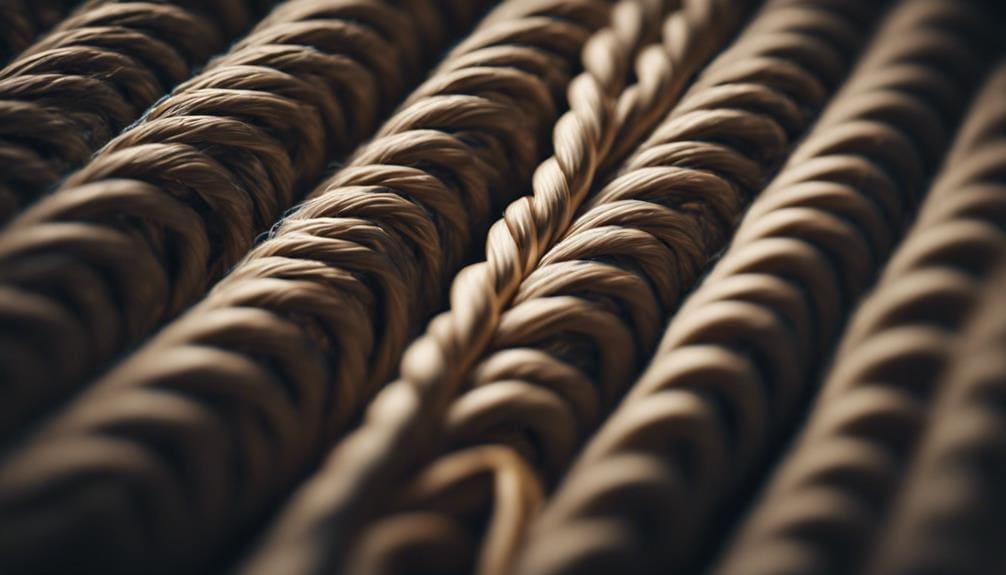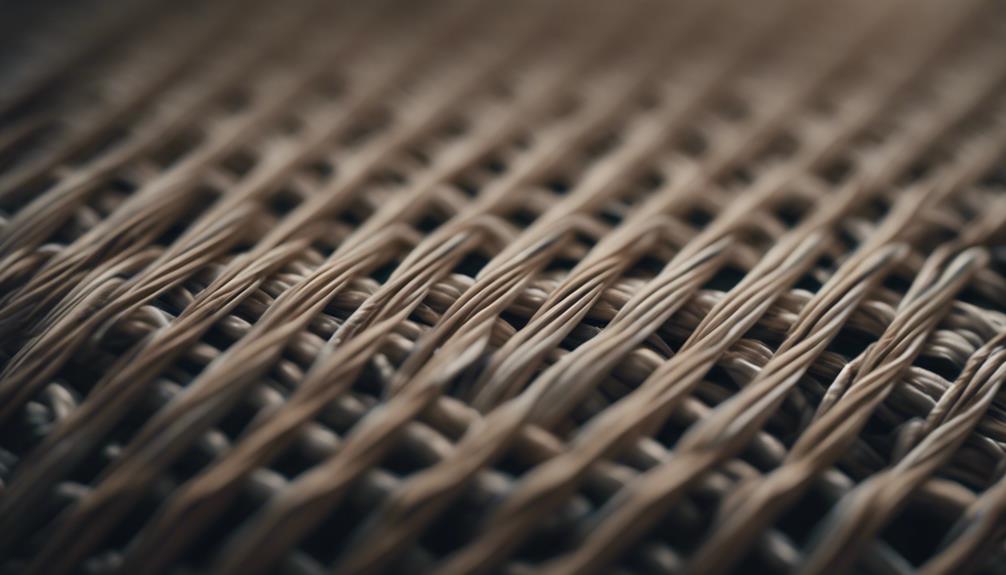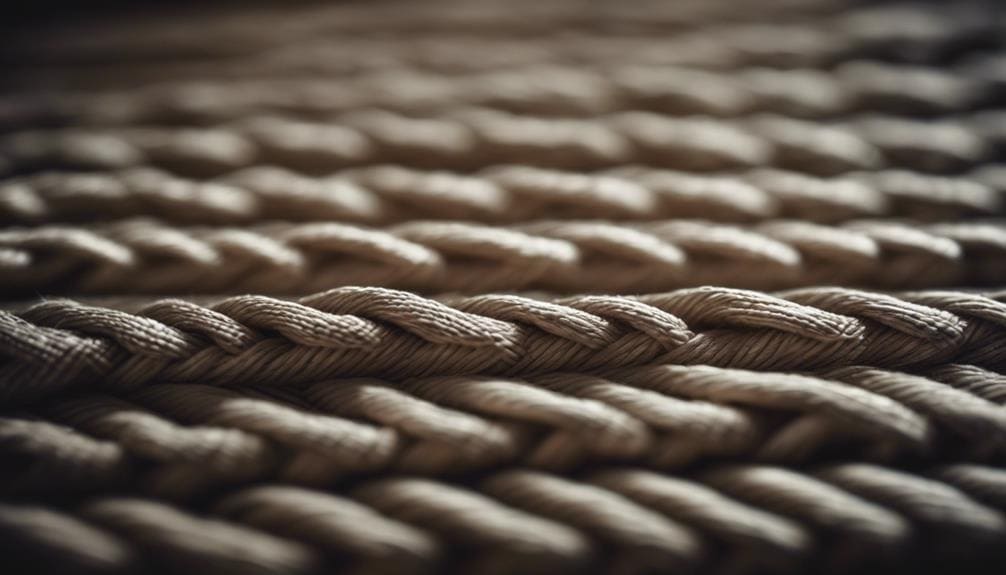Danish Cord Weaving Vs. Traditional Weaving
A study conducted by renowned design experts discovered that Danish Cord Weaving offers a unique aesthetic appeal and boasts exceptional durability compared to traditional weaving methods.
Exploring the intricate techniques and materials used in Danish cord weaving versus traditional weaving opens up a world of design possibilities and functional advantages as we unravel the characteristics and differences between these two weaving styles, a deeper understanding of their impact on furniture craftsmanship and design evolution emerges, shedding light on the nuances that set them apart in woven artistry.
In comparing Danish Cord Weaving to Traditional Weaving, Danish Cord involves wrapping paper cord around a frame, while Traditional Weaving uses interlacing threads on a loom.
Key Takeaways
- Danish cord weaving emphasizes modern aesthetics and durability.
- Traditional weaving focuses on intricate designs and cultural richness.
- Danish cord weaving offers easy maintenance and longevity.
- Traditional weaving showcases diverse natural fibers and traditional styles.
Danish Cord Weaving Characteristics
In Danish cord weaving, the intricate patterns woven using paper cord around a wooden frame exemplify a fusion of functionality and aesthetic appeal. The weaving intricacies in Danish cord creations go beyond mere support; they create unique patterns that elevate the overall design. These patterns enhance the furniture’s visual appeal and showcase the craftsmanship and attention to detail characteristic of Danish design.
When comparing Danish cord weaving to traditional weaving techniques, the emphasis on these unique patterns stands out as a defining feature. While traditional weaving may focus more on durability and structure, Danish cord weaving marries these elements with a keen eye for design, resulting in pieces that are not only sturdy but also visually striking. The ability to achieve such intricate patterns with paper cords demonstrates the innovation and skill present in Danish cord weaving, setting it apart as a true art form within furniture design.
Traditional Weaving Techniques Overview

Transitioning from the intricate patterns of Danish cord weaving, traditional weaving techniques encompass a rich history of interlacing fibers or threads to craft textiles and patterns focusing on craftsmanship and attention to detail. Traditional weaving holds immense cultural significance, acting as a form of artistic expression deeply rooted in heritage and tradition. The historical evolution of traditional weaving techniques reflects global influences, with each culture infusing its unique style and symbolism into the fabrics created.
- Craftsmanship and Attention to Detail: Hand weaving is common in traditional weaving, emphasizing the meticulous skill and dedication required to create intricate designs.
- Variety of Weaving Techniques: Techniques like plain weave, twill weave, and satin weave form the foundation of traditional weaving, each offering distinct textures and patterns.
- Cultural Diversity: Traditional weaving methods vary across cultures and regions, showcasing a diverse range of patterns, colors, and materials that reflect the rich tapestry of human creativity.
Materials Used in Danish Cord Weaving

Utilizing paper cord crafted from twisted paper strips sets Danish cord weaving apart from traditional techniques, offering a durable and distinctive material for creating intricate furniture designs. The durability and aesthetics of the paper cord used in Danish cord weaving make it a standout choice for modern furniture craftsmanship. Unlike traditional weaving materials such as rush or seagrass, the paper cord used in Danish cord weaving undergoes a meticulous twisting and weaving process by hand, emphasizing the craftsmanship of these unique pieces.
| Durability | Aesthetics | Modern |
|---|---|---|
| Strength | Stylish | Approach |
| Longevity | Distinct | Innovation |
| Robustness | Elegant | Contemporary |
The careful selection of materials in Danish cord weaving reflects a blend of traditional techniques with a contemporary twist, resulting in furniture designs that are visually appealing and built to last. This modern approach to using paper cords showcases the evolution of weaving methods toward creating durable and stylish pieces.
Comparison of Weaving Processes

Precision and uniformity distinguish Danish cord weaving from traditional techniques, emphasizing structural support and a clean, contemporary aesthetic. Danish cord weaving involves wrapping paper cords around a wooden frame, creating intricate patterns that differ significantly from traditional methods utilizing natural fibers like wool or cotton.
The modern applications of Danish cord weaving are evident in its focus on achieving tight, symmetrical weaves for furniture, contrasting with the organic, free-form nature of traditional weaving. The weaving intricacies in Danish cord techniques highlight specific processes to ensure durability and longevity, reflecting a departure from the more expressive nature of traditional weaving.
This emphasis on precision and uniformity in pattern and tension gives Danish cord weaving its distinct clean and contemporary look, in contrast to the textured and varied appearance associated with traditional weaving. The cultural influences and historical significance embedded in these weaving processes further underline the evolution of craftsmanship and design aesthetics over time.
Design Elements in Danish Cord Vs. Traditional Weaving

Drawing a sharp contrast in design philosophy, Danish cord weaving and traditional weaving diverge significantly in their approach to incorporating design elements. Danish cord weaving, known for its clean lines and minimalistic aesthetics, embraces modern design sensibilities.
Geometric forms play a significant role in Danish cord weaving, adding a contemporary touch to furniture pieces. This style emphasizes simplicity, durability, and functionality, aligning with the principles of modernism and minimalism. On the other hand, traditional weaving techniques focus on intricate patterns, decorative motifs, and cultural symbolism.
Materials such as wool, cotton, or silk are commonly used in traditional weaving to express cultural heritage and artistic traditions. Danish cord weaving, emphasizing understated elegance and mid-century modern influences, starkly contrasts the expressive and narrative-driven qualities often associated with traditional weaving. The shift towards modern aesthetics in Danish cord weaving reflects a departure from traditional weaving designs’ ornate details and complexity.
Functional Differences Between the Two

In exploring the functional disparities between Danish cord and traditional weaving, the choice of materials and techniques employed distinctly shapes the intended purpose and aesthetic outcomes of the respective crafts. Danish cord weaving, with its paper cord around a wooden frame, focuses on creating intricate patterns for chair seats and backrests, emphasizing visual appeal and support. On the other hand, traditional weaving techniques, using fabric or other materials on various looms, offer versatility in applications such as rugs, tapestries, and clothing.
- Structural Differences: Danish cord weaving emphasizes clean lines and Scandinavian design influence, creating a modern aesthetic. In contrast, traditional weaving can produce more diverse textures and patterns due to the varied materials used.
- Aesthetic Outcomes: Danish cord weaving showcases a minimalist and sleek appearance, fitting well with contemporary interiors, whereas traditional weaving can evoke cultural heritage and historical significance through intricate designs.
- Practical Applications: Danish cord weaving is commonly used in furniture design, particularly in mid-century modern Danish styles, while traditional weaving finds applications in a broader array of textiles and crafts, reflecting its cultural versatility.
Pros and Cons of Each Weaving Style

When comparing Danish cord weaving to traditional weaving, it becomes evident that each style brings unique advantages and drawbacks. Danish cord weaving offers a modern and sleek aesthetic, perfect for those who appreciate minimalist design. On the other hand, traditional weaving often showcases intricate patterns and designs, appealing to those who prefer a more rustic or traditional look.
Let’s delve deeper into the pros and cons of each weaving style:
| Aspect | Danish Cord Weaving | Traditional Weaving |
|---|---|---|
| Pros | Modern aesthetic, durability, longevity | Intricate designs, natural fiber authenticity |
| Cons | Limited pattern variety, maintenance needs | Less durability, may require more upkeep |
| Style Preference | Minimalist, contemporary | Rustic, traditional |
| Maintenance Considerations | Easy to clean, resistant to wear and tear | Requires more upkeep, may be prone to damage |
Whether you prefer the clean lines of Danish cord weaving or the traditional charm of natural fibers, your style preference and maintenance considerations play a significant role in choosing the weaving style that best suits your needs.
Frequently Asked Questions
What Is Danish Weaving?
Danish weaving techniques involve intricate cord weaving styles around a wooden frame, creating furniture with support and visual appeal. The process emphasizes patterns and craftsmanship, reflecting a blend of tradition and innovation in design.
Which Is Better Laced or Unlaced Danish Cord?
In deciding between laced and unlaced Danish cord, I weigh durability against comfort. Laced offers a tighter finish for longevity, while unlaced provides simplicity and a modern touch. The choice depends on balancing aesthetics with practicality.
Is Danish Cord Comfortable?
Yes, the Danish cord provides exceptional comfort in seating due to its ergonomic design and ability to adapt to body contours. The tight weaving ensures firm yet cozy support, making it a preferred choice for comfortable seating.
How Long Does Danish Cord Last?
You might think high maintenance costs can be a concern, but let me share that the Danish cord’s longevity is exceptional. Proper care can last for generations, making it a sustainable and durable choice for furniture weaving.
Conclusion
In the intricate dance of weaving styles, the Danish cord emerges as the graceful swan, embodying elegance and sophistication. Its seamless blend of form and function creates a timeless allure, captivating all who gaze upon its beauty. Traditional weaving, on the other hand, stands as the sturdy oak tree, rooted in history and tradition. Each with its unique charm and purpose, these weaving techniques intertwine to form a rich tapestry of craftsmanship and artistry.







